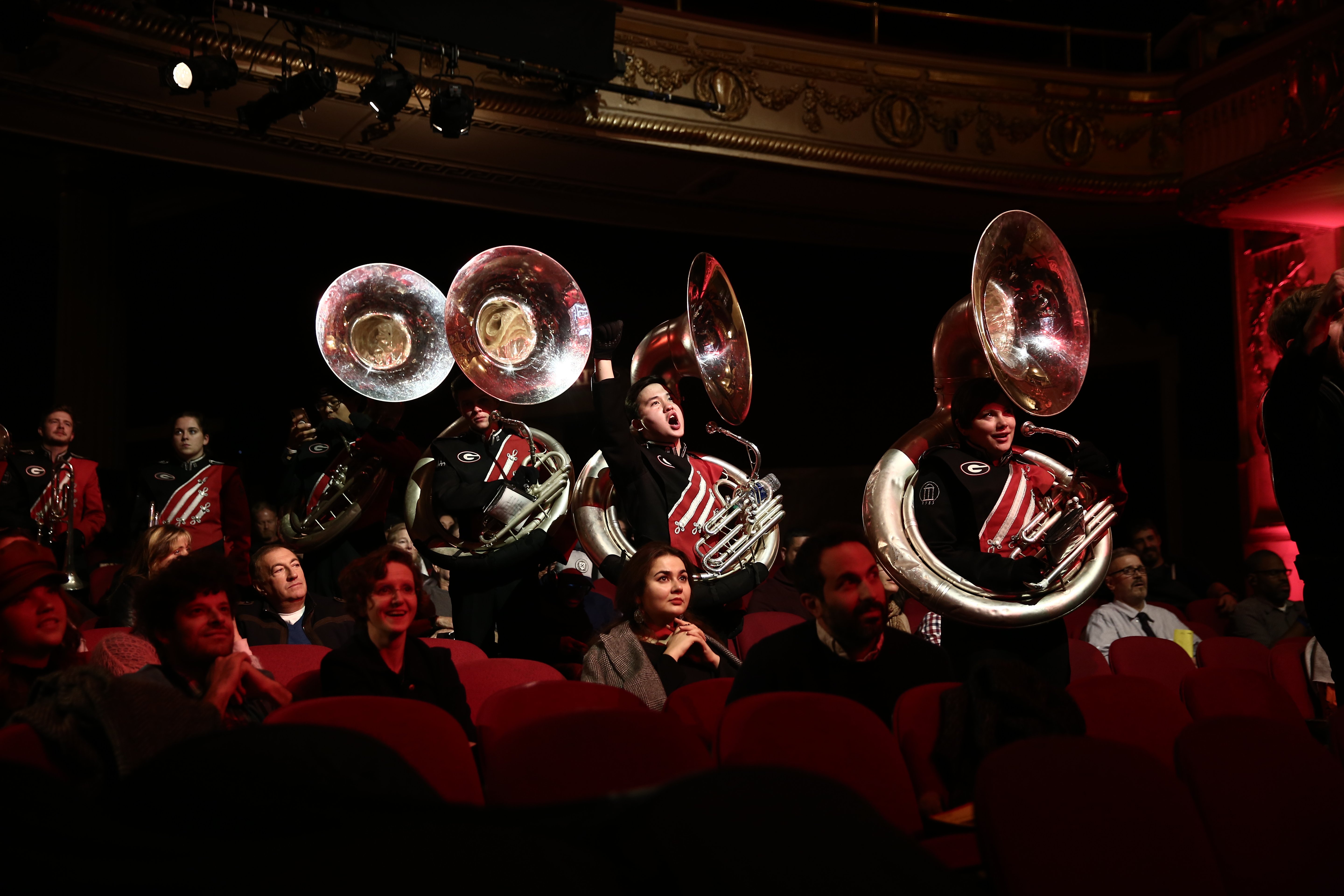
Performa, the New York performance biennial that’s now in its 16th year, has developed a reputation for forcing artists into unfamiliar territory. Indeed, for many artists, Performa commissions are their first opportunities to arrange events, which presents unique challenges.
The learning curve can be steep, and artists often have to learn on the fly. For many artists, the unpredictability is precisely the appeal: the chance to take a big risk can be a transformative opportunity.
As Performa comes to a close this weekend, we spoke with three artists doing live events for the first time to see what they learned from their experiences.
Paul Pfeiffer, University of Georgia Redcoat Band Live (2019). Photo: Paula Court.
Be Ready to Completely Rearrange Your Plans
When Paul Pfeiffer planned to bring the University of Georgia’s marching band to New York for his Performa outing, he envisioned them playing in an empty stadium. The original idea was to recontextualize how the band is perceived (they usually perform at football games) by placing them in an arena with no athletes in sight.
Pfeiffer even had one of the city’s major stadiums lined up for the performance. But late in the process, the NBA swooped in and outbid the artist for the venue.
The irony that the NBA quashed his performance—which emphasizes the corporate spectacle of professional sports—was not lost on Pfeiffer. But it still left him with a problem to solve: where would the 50-member band play now? Eventually, he locked down the historic Apollo Theater in Harlem, which opened up new possibilities, Pfeiffer explains.
“The band is nothing if not a machine; they are constantly on script,” the artist says. “To turn them into performers in a different context was a total unknown. And to an extent beyond what I anticipated, they performed their roles as hype generators in an amazing way. The audience had access to them, not just as a group, but individually. There were interactions happening that I did not expect. Individual personalities of the band members came out.”
Paul Pfeiffer, University of Georgia Redcoat Band Live (2019). Photo: Paula Court.
The change also spurred Pfeiffer to expand the piece: while some members of the band played in New York, those who didn’t make the trip performed simultaneously at the vacant University of Georgia stadium. Their performance was then live-streamed at the Apollo.
“The whole thing was an improvised negotiation happening in real-time,” Pfeiffer says.
“There’s a grey area between the notion that performance is something that happens on a stage, and a wider idea of performance as all human behavior,” he adds. “That’s absolutely fascinating to me. That’s what makes performance so exciting and pertinent right now. As an artist, that’s where the action is.”
Installation view of Tara Subkoff’s “DEEPFAKE,” 2019. Courtesy of the Hole.
Don’t Be Afraid to Let Your Children Get Involved
“It was a very personal piece,” says Tara Subkoff of her Performa commission, Deepfake.
An exploration of chaos theory and the way in which our lives are shaped by the choices we make moment-to-moment, the work was simultaneously staged at four different locations, which forced viewers to pick just one perspective on the sprawling event. Dancers moved to a capella renditions of a Nina Simone song at two separate churches uptown, while in Brooklyn, another group performed a water ballet.
And at the Hole, the gallery where Subkoff currently has a solo show, she staged a three-ring circus with jugglers, a mime, a magician, and a contortionist. As they pranced about, the artist chased her daughter around in a circle while her cousin, a tap dancer, performed nearby.
Subkoff didn’t plan on being in the piece herself. (The one time she starred in her own work was, according to her, “the worst piece” she’s ever done. “It was worse than the time I sang karaoke in Tokyo and cleared the room,” she says.) But her three-year-old daughter insisted on being part of the work, and so Subkoff decided to participate too.
“It was a comedic version of what it’s like to be a female in our society, trying to be all these things to all these people at the same time,” Subkoff says of the performance. “As a single mom, I feel like I’m always running in circles and juggling.”
Éva Mag, Stand Up, still (2015). Courtesy of the artist.
Trust Performa
There’s a Swedish expression (köpa grisen i säcken, which translates roughly to “buy a pig in a sack”) that’s used to describe a situation in which you agree to do something without really knowing what it is.
Éva Mag, a Swedish sculptor and performance artist, says Performa was her pig in a sack.
“It was a challenge for me to understand what this is, who the artists are, and how I fit in,” Mag says. “I’m doing a project I haven’t done before in a new environment. I had to figure out how to get the help I needed. I had no idea what the outcome was going to be.”
As a performer, Mag explains, “you have to learn not to be totally nervous and freeze, but actually trust yourself and go on.”
Mag’s work, Dead Matter Moves, is a durational performance that took place across six nights at the historic Judson Memorial Church. It features 10 performers erecting lifesize figures of clay and stuffing them into patchwork “skins” made of found textiles.
Mag says that talking with Performa curator Kathy Noble played a big part in shaping the piece, as did working with a production team—something she’s never done before.
“They helped with small details like scheduling throughout the day, and setting up the space for me to totally develop myself and investigate my techniques,” says the artist. “They pushed me to do more and to grow. That is really American—you can dream big!”